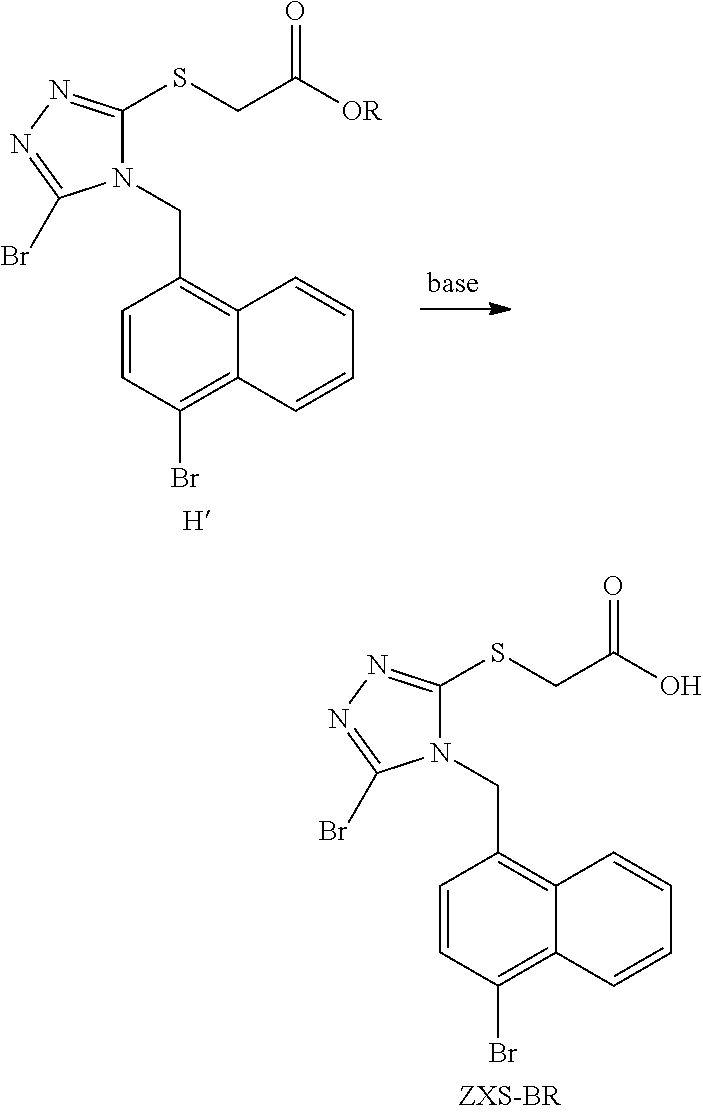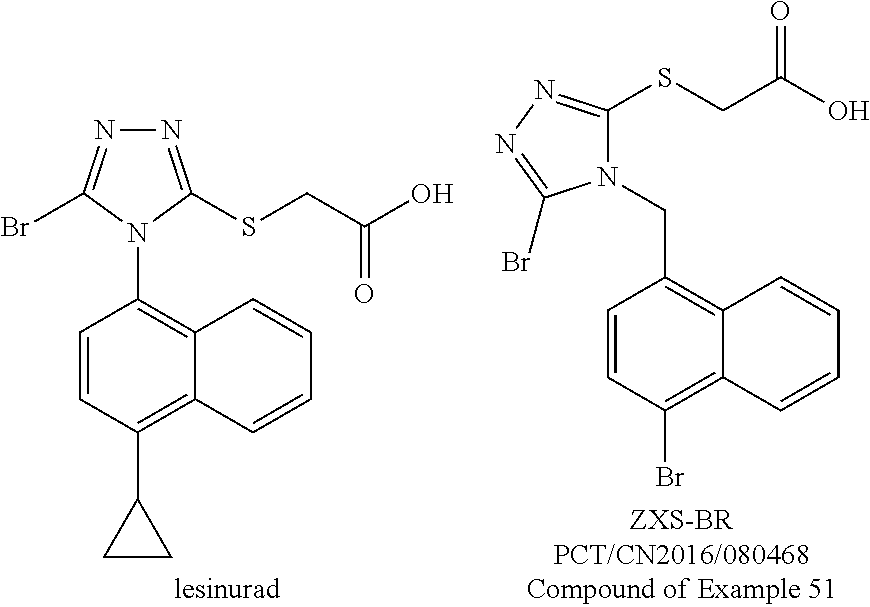Method for preparing urate transporter 1 inhibitor
a technology of urate transporter and inhibitor, which is applied in the field of pharmaceuticals, can solve the problems of severe side effects of drugs, joint deformation and nephrolithiasis, and serious impact on patients' life quality and health
- Summary
- Abstract
- Description
- Claims
- Application Information
AI Technical Summary
Benefits of technology
Problems solved by technology
Method used
Image
Examples
example 1
Synthetic Route of PCT / CN2016 / 080468
[0059]
Step 1. Synthesis of Compound B
[0060]To a dry 1 L round bottom flask were added compound A (1,4-dibromonaphthalene, 57.19 g, 200 mmol), CuCN (10.75 g, 120 mmol) and DMF (600 mL), and the resulting mixture was stirred at 130° C. under nitrogen atmosphere for 12 hours.
[0061]The reaction mixture was cooled to room temperature and transferred to a 5 L flask. Ethyl acetate (1.8 L) was added, and the resulting mixture was stirred at room temperature for 2-3 hours to give a grayish brown slurry. The slurry was filtered by suction, and the filtrate was collected. The filter cake was washed with a small amount of ethyl acetate, and the washing liquid was combined into the filtrate. The filtrate was washed with water (1 L×5), dried over anhydrous sodium sulfate, and evaporated on a rotary evaporator to remove the solvent. To the resulting yellow solid was added ethyl acetate-petroleum ether (400 mL, a volume ratio of 1:3), and the resulting mixture wa...
example 2
Screening Study on Reaction Conditions in the Step of B′→C′
[0075]
[0076]It is recognized by one of ordinary skill in the art that free radical halogenation at the benzylic position of an aralkyl group is generally carried out by heating in a solvent such as CCl4 with NBS (N-bromosuccinimide) or NCS (N-chlorosuccinimide) as a halogenating agent, BPO or azodiisobutyronitrile (AIBN) and the like as a radical initiator. However, the inventors of the present invention had found that the reaction proceeds unsmoothly in a solvent recognized by a person skilled in the art such as CCl4, and thus carried out a intensive and delicate optimization and screening of the main reaction conditions of the reaction, that is, the halogenating agent, the radical initiator and the reaction solvent, and finally found that n-hexane is the most appropriate solvent, BPO is the optimal radical initiator, and NBS is the best halogenating reagent for this reaction.
[0077]Reaction operations: to a dry 250 mL round...
example 3
Screening Study on Reaction Temperature in the Step of C′ to D
[0079]
[0080]It is recognized by one of ordinary skill in the art that the reaction of an aromatic benzyl halide with a thiocyanate is relatively easy. Since the reaction can generally be carried out at a lower temperature, there is generally no motivation to operate at a higher temperature (for the sake of saving energy and power consumption). Therefore, when trying to react C′ with KSCN in DMF at room temperature, we found that the reaction was very rapid (completed within 0.5 hours), and a single product was obtained. But after separation and structural identification, it was found that the product was not the desired D (an isothiocyanate), but its isomer D′ (a thiocyanate), with the latter being a product of the reaction of S-terminal of thiocyanate ion in KSCN with C′. To this end, we carried out a detailed and intensive study on the types of thiocyanate and the temperatures of the reaction, and finally found that the...
PUM
| Property | Measurement | Unit |
|---|---|---|
| temperature | aaaaa | aaaaa |
| temperature | aaaaa | aaaaa |
| temperature | aaaaa | aaaaa |
Abstract
Description
Claims
Application Information
 Login to View More
Login to View More - R&D
- Intellectual Property
- Life Sciences
- Materials
- Tech Scout
- Unparalleled Data Quality
- Higher Quality Content
- 60% Fewer Hallucinations
Browse by: Latest US Patents, China's latest patents, Technical Efficacy Thesaurus, Application Domain, Technology Topic, Popular Technical Reports.
© 2025 PatSnap. All rights reserved.Legal|Privacy policy|Modern Slavery Act Transparency Statement|Sitemap|About US| Contact US: help@patsnap.com



